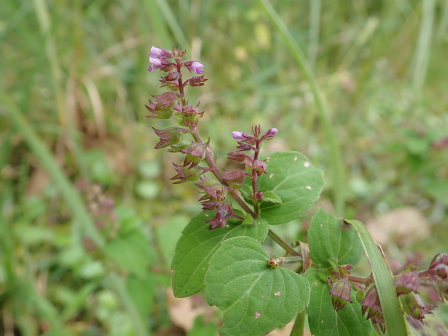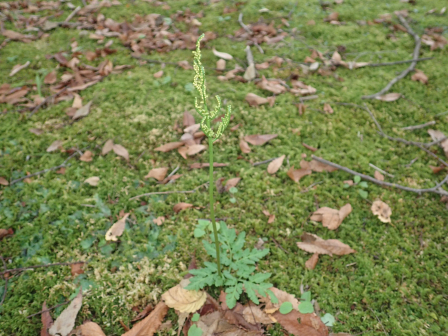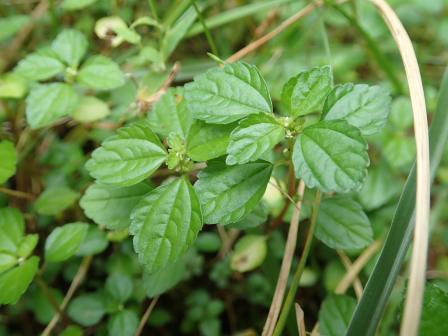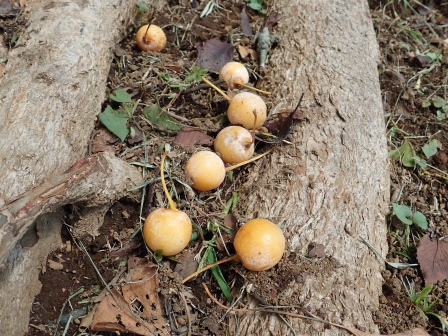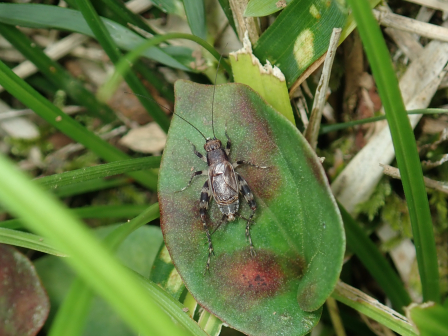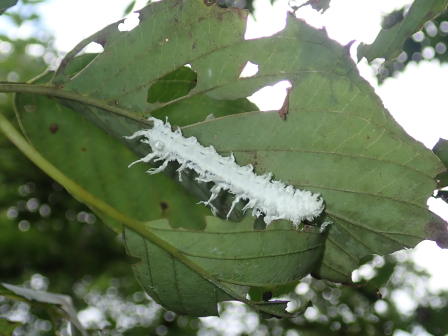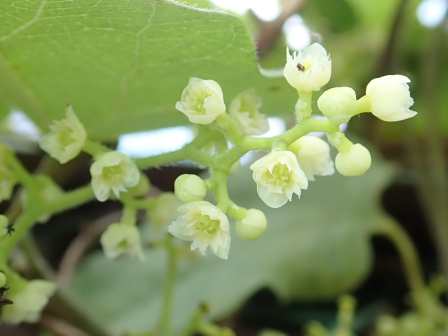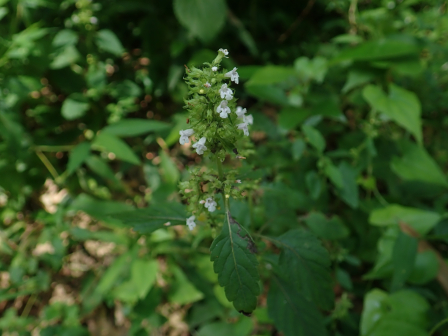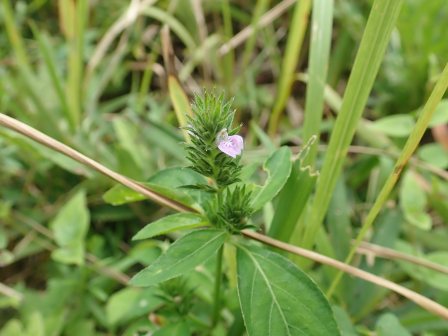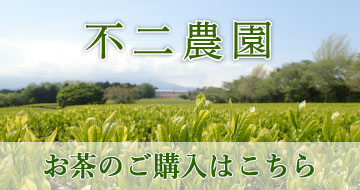フィールド日記
2022.10.21
イヌコウジュ
第二オークヒルでイヌコウジュが咲いています。明るい草地などに生えるシソ科の一年草です。似ている植物にヒメジソがありますが、茎に下向きの細い毛が密生するなどの特徴から見分けることができます。
"Inu-Kouju (イヌコウジュ)" plants are in bloom in the Second Oak Hill. They are an annual mint-family plants that grow on the sunny grassland. There is a similar plant called "Himejiso (ヒメジソ)", but you can tell "Inu-Kouju" from "Himejiso" by the fact that "Inu-Kouju" has dense thin hair on its stem.
2022.10.18
フユノハナワラビ
中学校舎の中庭にフユノハナワラビが胞子をつけていました。名前の通り秋から冬にかけて葉を広げ、胞子を飛ばすシダ植物です。シダ植物は葉の裏面に胞子をつけるものが多いですが、フユノハナワラビは、胞子嚢をつける胞子葉と、光合成をする栄養葉に分かれています。和名のハナとは、写真の中央の、黄色い胞子嚢を多数つけた胞子葉を花に見立てたものです。
I found "Fuyuno-Hana-Warabi (フユノハナワラビ)" fern plants bearing spores. As the name suggests, they are fern plants that spread spores in winter with their leaves growing. Many fern plants have spores on the back of their leaves, but this fern has the fertile leaves that produce spores and the sterile leaves that carry out photosynthesis. The word "Hana (ハナ)" in their name means "flower" and comes from their fertile leaves looking like a flower.
2022.10.14
ミズ
第二オークヒルでミズが咲いていました。湿った場所に生える1年草で、花は葉腋にまとまってつき、あまり目立ちません。和名は、全体に水分が多く、みずみずしいことが由来です。
"Mizu" plants are in bloom in the Second Oak Hill. They are an annual plant growing in humid places. Their flowers gather on their leaf axils and do not stand out very much. The name comes from the fact that they contain lots of water in their bodies.
2022.10.11
ススキ
キャンパス内のあちこちでススキが穂を出しています。写真の奥の株のように穂が紫色のものが混ざっており、これをムラサキススキと呼びます。しかし、中間的な色の株もあり、色の変化は連続的に思えます。
Japanese pampas grasses are in bloom here and there in our campus. You can see in the back of the photo "Murasaki-Ssusuki", the pampas grass blooming purple flowers, as well as white ones. However, some strains are intermediate in color, so you can enjoy the graduation of various colors in some places.
2022.10.07
イチョウ
グラウンド横のイチョウの木の下にギンナンがたくさん落ちています。イチョウは裸子植物ですので、植物学上は外側の果肉状の部分も含めて果実ではなく種子になります。果肉状の部分は取り除き、硬い殻につつまれた中身(胚乳の部分)を食用とします。
I have found many ginkgo nuts under an "Ichou (イチョウ)" tree by the schoolground. "Ichou (イチョウ)" trees are a gymnospermous plant, so botanically, ginkgo nuts, including an outside part that looks like a fleshy fruit, are not fruit but seeds. When we eat ginkgo nuts, we remove the part that looks like a fleshy fruit, and we eat the core covered by a hard shell.
2022.10.04
カワラスズ
第1オークヒルの土手でカワラスズを見つけました。マダラスズに似ていますが、翅の付け根や小あごひげと呼ばれる部分が白いことで見分けることができます。美しい声で鳴く虫としても知られています。
I found a cricket called "Kawara-Suzu (カワラスズ)" on the bank in the First Oak Hill. They are similar to "Madara-Suzu", but you can tell "Kawara-Suzu カワラスズ)" from "Madara-Suzu (マダラスズ)" by the fact that the base of their wings and a part called "maxillary palpus" are white. They are well known as an insect singing beautifully.
2022.09.30
アゲハモドキ
共生の森でアゲハモドキという蛾の幼虫を見つけました。白いロウ状の物質に覆われています。食草はミズキ類で、この個体はクマノミズキの木にいました。成虫はジャコウアゲハにそっくりな姿をしています。
I found a larva of a moth called "Ageha-Modoki (アゲハモドキ)" in the Kyoseinomori (共生の森). They eat leaves of trees belonging to "Mizuki (ミズキ)" group and this larva was on a leaf of a "Kumano-Mizuki (クマノミズキ)" tree. Their adults look like a butterfly called "Jakou-Ageha (ジャコウアゲハ)."
2022.09.27
アオツヅラフジ
グラウンドでアオツヅラフジが咲いていました。がくと花弁がそれぞれ6枚ずつありますが、どちらもクリーム色をしていて花弁のように見えます。秋から冬にかけて青紫色の果実をつけ、中にはアンモナイトのような種子が入っていることで有名です。(種子のようすはこちら)
"Ao-Tsuzurafuji (アオツヅラフジ)" plants are in bloom in the school ground. They have 6 calyces and 6 petals and they are all cream-colored and look like petals. They are well known for the fact that they bear bluish purple fruit from fall to winter that contain the seeds looking like an ammonite fossil. (click here to see the seed.)
2022.09.23
イヌトウバナ
裏道でイヌトウバナが咲いていました。やや湿った林縁などによく見られます。植物では、ある植物に似て非なる植物の名前にイヌと付けることがあります。本種もトウバナに似ているので、イヌトウバナと呼ばれていると思われます。
"Inu-Toubana (イヌトウバナ)" plants are in bloom on the back road. They are often seen on the edges of humid forests. Some plants have the names starting with "Inu (イヌ)" when they look like diffrent relative species. This species has a relative species called "Toubana (トウバナ)", so this one is called "Inu-Toubana (イヌトウバナ)".
2022.09.20
キツネノマゴ
キツネノマゴが咲いています。日当たりの良い道ばたなどに生える1年草です。和名は花穂がキツネの尻尾のように見えることと、大きさが小さいことに由来するそうです。


